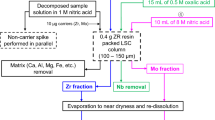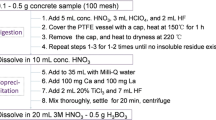Abstract
126Sn is one of the long-lived fission products that might have been released into the environment after the Fukushima nuclear accident in Japan in 2011. The presence of radionuclides must be monitored for the proper treatment of wastes obtained from decommissioning accident-related nuclear facilities and the surrounding environment. In the work, we propose a reliable method for verifying the presence of 126Sn in construction materials by combining the HCl-free solid phase extraction on TEVA® resin and a selective measurement by inductively coupled plasma tandem mass spectrometry (ICP-MS/MS). The method has been optimized and characterized. More than 95% of chemical recovery was achieved for Sn from typical concrete matrixes. The interference caused by an isobar 126Te and possible polyatomic interferences from matrixes were effectively suppressed by the developed chemical separation and the tandem MS/MS configuration. The total decontamination factor for the Te interference was of the order of 105. The estimated method detection limit for 126Sn in concrete as measured at m/z = 160 was 12.1 pg g− 1, which is equivalent to 6.1 mBq g− 1. In conclusion, the sensitivity of the developed method is comparative to the conventional radiation-counting methods and sufficient for verifying the presence of 126Sn in construction materials.



Similar content being viewed by others
References
Japan Ministry of Economy, Trade and Industry, METI (2021) Storage conditions of the rubble and tree. Available at: https://www.meti.go.jp/earthquake/nuclear/decommissioning/committee/osensuitaisakuteam/2017/07/3-04-02.pdf. In Japanese. Accessed on Nov 2021
Lehto J, Hou X (2011) Chemistry and analysis of radionuclides laboratory techniques and methodology. Wiley–VCH, Weinheim
Hou X (2019) Radioanalysis of ultra-low level radionuclides for environmental tracer studies and decommissioning of nuclear facilities. J Radioanal Nucl Chem 322:1217–1245
Croudace IW, Russell BC, Warwick PE (2017) Plasma source mass spectrometry for radioactive waste characterisation in support of nuclear decommissioning: a review. J Anal At Spectrom 32:494–526
McCurdy E, Woods G, Sugiyama N (2019) Method development with ICP-MS/MS: tools and techniques to ensure accurate results in reaction mode. Spectroscopy, special issue 34(9):20–27, 34. Online version at http://www.spectroscopyonline.com/method-development-icp-msms-tools-and-techniques-ensure-accurate-results-reaction-mode
Warwick FE, Russell BC et al (2019) Evaluation of inductively coupled plasma tandem mass spectrometry for radionuclide assay in nuclear waste characterisation. J Anal At Spectrom 34:1810–1821
Bu W, Ni Y, Steinhauser G et al (2018) The role of mass spectrometry in radioactive contamination assessment after the Fukushima nuclear accident. J Anal At Spectrom 33:519–546
Hou X, Roos P (2008) Critical comparison of radiometric and mass spectrometric methods dor the determination of radionuclides in environmental, biological and nuclear waste samples. Anal Chim Acta 608:105–139
Zhu Y, Ariga T, Nakano K, and Shikamori Y (2021) Trends and advances in inductively coupled plasma tandem quadrupole mass spectrometry (ICP-QMS/QMS) with reaction cell. At Spectrosc 42. Link access: http://www.at-spectrosc.com/as/article/pdf/2021710
Do VK, Furuse T et al (2021) Development of HCl-free solid-phase extraction combined with ICP-MS/MS for rapid assessment of difficult-to-measure radionuclides. Part I: Selective measurement of 93Zr and 93Mo in concrete rubble. J Radioanal Nucl Chem 327:543–553
Dulanska S, Remenec B et al (2017) Development of 126Sn separation method by means of anion exchange resin and gamma spectroscopy. Appl Radiat Isotopes 123:128–132
Dulanska S, Bilohusein J et al (2016) Sequential determination of 93Zr, 94Nb, 99Tc and 126Sn in radioactive waste using anion exchange resin and TEVA® Resin. J Radioanal Nucl Chem 309:685–689
Dulanska S, Bilohusein J et al (2015) Determination of 126Sn in radioactive waste using TEVA® resin and gamma spectrometry. J Radioanal Nucl Chem 304:1093–1097
Andris B, Beňa J (2016) The development of 126Sn separation procedure by means of TBP resin. J Radioanal Nucl Chem 308:781–788
Asai S, Toshimitsu M et al (2013) Isotope dilution inductively coupled plasma spectrometry for determination of 126Sn content in spent nuclear fuel sample. J Nucl Sci Technol 50(6):556–562
Gartermann P, Golser R et al (1996) Absolute measurement of 126Sn radionuclide concentration with AMS. Nucl Instrum Meth B 114(1–2):125–130
Shen H, Jiang S, He M et al (2011) Study on measurement of fission product nuclide 126Sn by AMS. Nucl Instrum Meth B 269(3):392–395
Gautier C, Degros JP et al. (2015) Measurement of long-lived Sn-121m and Sn-126 nuclides in low and intermediate level nuclear waste. In: 10th International Conference on Methods and Applications of Radioanalytical Chemistry, USA
Rahman MM, MacDonald C, Cornett RJ (2018) Separation of tin from tellurium: performance of different extraction chromatographic materials. Sep Sci Technol 53(13):2055–2063
Reference information of elemental composition of concrete. Access: https://www.nustec.or.jp/anzenjissho/introduction/ga1_4.html (Accessed in Nov 2021, in Japanese)
Reference information of CRM sedimentary rock JSd-1. Access: http://www.seishin-syoji.co.jp/files/libs/39/201604131839398434.pdf (Accessed in Nov 2021)
Hu Z, Qi L (2014) Sample digestion methods. Treatise on Geochemistry (Second Edition) 15:87–109
Ohta Y, Do VK et al. Removal of interferences for ultrasensitive detection of 126Sn in radioactive rubbles by ICP-MS/MS, Annual meeting of Japan Atomic Energy Society, March 2021, 2H03, in Japanese
Japan Nuclear Safety Commission (2007) Radioactivity concentration upper limit for the disposal of low-level radioactive solid waste. In: Japanese. Available at: https://www.rwmc.or.jp/law/file/shiryo_14.pdf Accessed in Nov 2021
Acknowledgements
Authors are grateful to Mr. Yoshiaki Motoki and Mr. Tsubasa Endo (Tokyo Power Technology Ltd.) for their support of ICP-MS measurement. Authors thank Ms. Kiyoko Kurosawa (Ascend Co. Ltd.) for her support of sample decomposition and useful advices. The study is carried out under the research program based on subsidy to the International Research Institute for Nuclear Decommissioning (IRID) by Ministry of Economy, Trade and Industry, Japan.
Author information
Authors and Affiliations
Corresponding author
Ethics declarations
Conflicts of interest
The authors declare no conflict of interest regarding the data presented in the article.
Additional information
Publisher's Note
Springer Nature remains neutral with regard to jurisdictional claims in published maps and institutional affiliations.
Supplementary Information
Below is the link to the electronic supplementary material.
Rights and permissions
Springer Nature or its licensor holds exclusive rights to this article under a publishing agreement with the author(s) or other rightsholder(s); author self-archiving of the accepted manuscript version of this article is solely governed by the terms of such publishing agreement and applicable law.
About this article
Cite this article
Do, VK., Furuse, T., Ohta, Y. et al. Development of HCl-free solid-phase extraction combined with ICP-MS/MS for rapid assessment of difficult-to-measure radionuclides. Part II: Highly sensitive monitoring of 126Sn in concrete rubble. J Radioanal Nucl Chem 331, 5631–5640 (2022). https://doi.org/10.1007/s10967-022-08612-7
Received:
Accepted:
Published:
Issue Date:
DOI: https://doi.org/10.1007/s10967-022-08612-7




